Sven Jacobsson
EVM Analysis of Distributed Massive MIMO with 1-Bit Radio-Over-Fiber Fronthaul
May 29, 2024Abstract:We analyze the uplink performance of a distributed massive multiple-input multiple-output (MIMO) architecture in which the remotely located access points (APs) are connected to a central processing unit via a fiber-optical fronthaul carrying a dithered and 1-bit quantized version of the received radio-frequency (RF) signal. The innovative feature of the proposed architecture is that no down-conversion is performed at the APs. This eliminates the need to equip the APs with local oscillators, which may be difficult to synchronize. Under the assumption that a constraint is imposed on the amount of data that can be exchanged across the fiber-optical fronthaul, we investigate the tradeoff between spatial oversampling, defined in terms of the total number of APs, and temporal oversampling, defined in terms of the oversampling factor selected at the central processing unit, to facilitate the recovery of the transmitted signal from 1-bit samples of the RF received signal. Using the so-called error-vector magnitude (EVM) as performance metric, we shed light on the optimal design of the dither signal, and quantify, for a given number of APs, the minimum fronthaul rate required for our proposed distributed massive MIMO architecture to outperform a standard co-located massive MIMO architecture in terms of EVM.
A TDD Distributed MIMO Testbed Using a 1-Bit Radio-Over-Fiber Fronthaul Architecture
Mar 26, 2024Abstract:We present the uplink and downlink of a time-division duplex distributed multiple-input multiple-output (D-MIMO) testbed, based on a 1-bit radio-over-fiber architecture, which is low-cost and scalable. The proposed architecture involves a central unit (CU) that is equipped with 1-bit digital-to-analog and analog-to-digital converters, operating at 10 GS/s. The CU is connected to multiple single-antenna remote radio heads (RRHs) via optical fibers, over which a binary RF waveform is transmitted. In the uplink, a binary RF waveform is generated at the RRHs by a comparator, whose inputs are the received RF signal and a suitably designed dither signal. In the downlink, a binary RF waveform is generated at the CU via bandpass sigma-delta modulation. Our measurement results show that low error-vector magnitude (EVM) can be achieved in both the uplink and the downlink, despite 1-bit sampling at the CU. Specifically, for point-to-point over-cable transmission between a single user equipment (UE) and a CU equipped with a single RRH, we report, for a 10 MBd signal using single-carrier 16QAM modulation, an EVM of 3.3% in the downlink, and of 4.5% in the uplink. We then consider a CU connected to 3 RRHs serving over the air 2 UEs, and show that, after over-the-air reciprocity calibration, a downlink zero-forcing precoder designed on the basis of uplink channel estimates at the CU, achieves an EVM of 6.4% and 10.9% at UE 1 and UE 2, respectively. Finally, we investigate the ability of the proposed architecture to support orthogonal frequency-division multiplexing (OFDM) waveforms, and its robustness against both in-band and out-of-band interference.
Hybrid Jammer Mitigation for All-Digital mmWave Massive MU-MIMO
Nov 25, 2021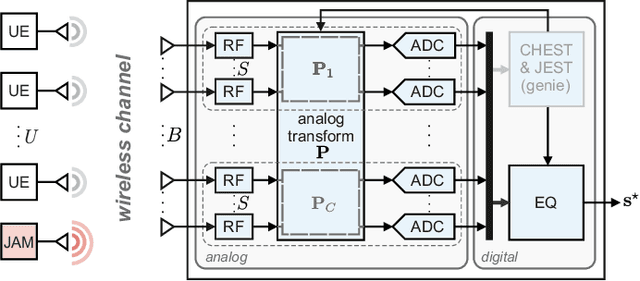
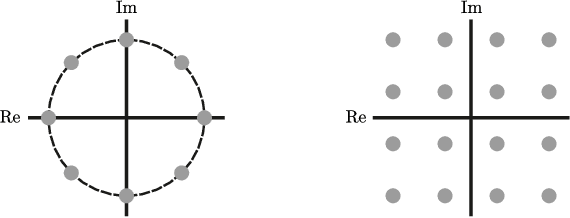


Abstract:Low-resolution analog-to-digital converters (ADCs) simplify the design of millimeter-wave (mmWave) massive multi-user multiple-input multiple-output (MU-MIMO) basestations, but increase vulnerability to jamming attacks. As a remedy, we propose HERMIT (short for Hybrid jammER MITigation), a method that combines a hardware-friendly adaptive analog transform with a corresponding digital equalizer: The analog transform removes most of the jammer's energy prior to data conversion; the digital equalizer suppresses jammer residues while detecting the legitimate transmit data. We provide theoretical results that establish the optimal analog transform as a function of the user equipments' and the jammer's channels. Using simulations with mmWave channel models, we demonstrate the superiority of HERMIT compared both to purely digital jammer mitigation as well as to a recent hybrid method that mitigates jammer interference with a nonadaptive analog transform.
Resolution-Adaptive All-Digital Spatial Equalization for mmWave Massive MU-MIMO
Jul 23, 2021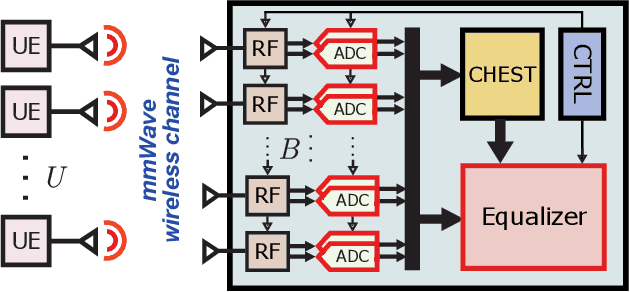


Abstract:All-digital basestation (BS) architectures for millimeter-wave (mmWave) massive multi-user multiple-input multiple-output (MU-MIMO), which equip each radio-frequency chain with dedicated data converters, have advantages in spectral efficiency, flexibility, and baseband-processing simplicity over hybrid analog-digital solutions. For all-digital architectures to be competitive with hybrid solutions in terms of power consumption, novel signal-processing methods and baseband architectures are necessary. In this paper, we demonstrate that adapting the resolution of the analog-to-digital converters (ADCs) and spatial equalizer of an all-digital system to the communication scenario (e.g., the number of users, modulation scheme, and propagation conditions) enables orders-of-magnitude power savings for realistic mmWave channels. For example, for a 256-BS-antenna 16-user system supporting 1 GHz bandwidth, a traditional baseline architecture designed for a 64-user worst-case scenario would consume 23 W in 28 nm CMOS for the ADC array and the spatial equalizer, whereas a resolution-adaptive architecture is able to reduce the power consumption by 6.7x.
Distortion-Aware Linear Precoding for Massive MIMO Downlink Systems with Nonlinear Power Amplifiers
Dec 24, 2020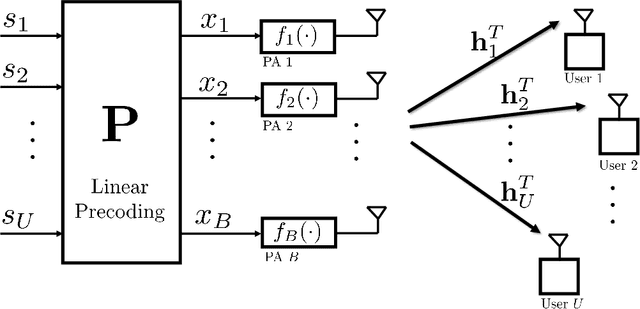


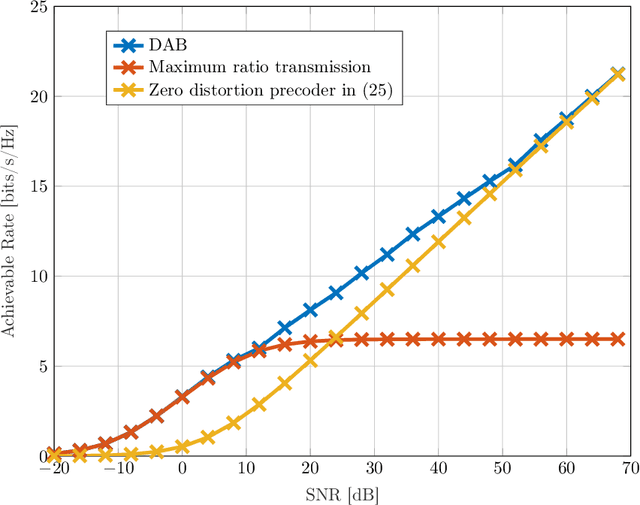
Abstract:We introduce a framework for linear precoder design over a massive multiple-input multiple-output downlink system and in presence of nonlinear power amplifiers (PAs). By studying the spatial characteristics of the distortion, we demonstrate that conventional linear precoding techniques steer nonlinear distortions in the direction of the users. We show that, by taking into account PA nonlinearity characteristics, one can design linear precoders that reduce, and in single-user scenarios, even remove completely the distortion transmitted in the direction of the users. This, however, is achieved at the price of a considerably reduced array gain. To address this issue, we present precoder optimization algorithms which simultaneously take into account the effects of array gain, distortion, multiuser interference, and receiver noise. Specifically, we derive an expression for the achievable sum rate and propose an iterative algorithm that attempts to find the precoding matrix maximizing this expression. Moreover, using a model for PA power consumption, we propose an algorithm that attempts to find the precoding matrix minimizing the consumed power for a given minimum achievable sum rate. Our numerical results demonstrate that the proposed distortion-aware precoding techniques yield considerable improvements in terms of spectral and energy efficiency compared to conventional linear precoding techniques.
 Add to Chrome
Add to Chrome Add to Firefox
Add to Firefox Add to Edge
Add to Edge